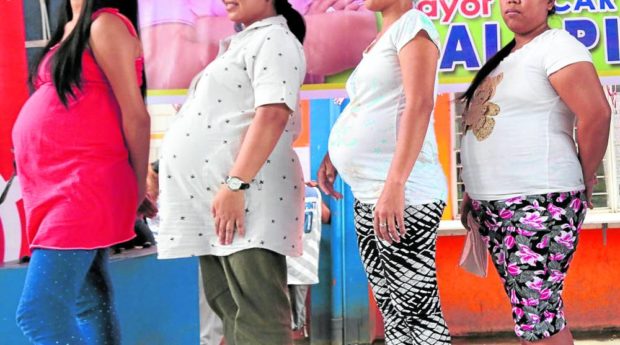Pandemic’s untold toll on pregnant women: Hardest yet

IDEAL | To achieve maternal health care, every pregnant woman should have at least four prenatal checkups, two postnatal checkups, and give birth and be attended to by a health professional in a facility, experts say. (INQUIRER FILE PHOTO)
MANILA, Philippines — Jennifer Apan, a 37-year-old public school teacher, went through her most difficult pregnancy yet last year with maternal health care inaccessible at times due to surges in COVID-19 cases.
Getting a checkup was stressful as well because of the required swab test that was also an added financial burden, she said.
“It was really the hardest pregnancy for me because movements were limited,” Apan told the Inquirer in a phone interview. Aside from being seated most of the time while teaching online, she could not go out for a walk or just to exercise because of quarantine restrictions.
Apan availed herself of free health-care services at the barangay health center near her house in Pasig City. However, she had only two prenatal checkups because the facility was forced to temporarily suspend operations when its staff had to be quarantined due to COVID-19.
Fortunately for her, there were no complications in her pregnancy and she gave birth in September, just before COVID-19 cases peaked again due to the more transmissible Delta variant.
Based on data from the Philippine Statistics Authority (PSA), 1,975 women died due to maternal causes in 2020, up from 1,458 in 2019.
Among regions, Calabarzon (Cavite, Laguna, Batangas, Rizal, Quezon) had the highest number of maternal deaths in 2020 with 344, followed by Metro Manila (277), Central Luzon and Central Visayas with 199 each.
In an online briefing recently, Zenaida Recidoro, an official of the Department of Health (DOH), said that pregnant women faced many challenges due to the pandemic, with quarantine restrictions affecting the delivery and utilization of maternal care services in 2020 and 2021.
“You couldn’t go out and there was no public transport, so that made a great impact on the utilization of services,” said Recidoro of the DOH’s adolescent and maternal health division.
“There were many questions [to the DOH] about how they would get to a health facility for prenatal care. And these were coming from women even from the provinces,” she added.
She also reported a decrease in facility-based birthing or those who give birth in hospitals and primary care centers such as birthing homes, rural health units, and lying-in clinics.
Pregnancy complications and maternal deaths are usually due to birthing outside health centers. The World Health Organization defines maternal death as “the death of a woman while pregnant or within 42 days of termination of pregnancy… from any cause related to or aggravated by the pregnancy or its management, but not from accidental or incidental causes.”
“Of course, mothers shouldn’t be dying. That is why our objective is to increase antenatal care coverage, increase facility-based delivery, and we have to increase postnatal coverage. We’re also hoping that we’ll be able to reduce unmet needs for family planning,” Recidoro said.
Lower mortality ratio
For this year, the government aims to reduce the maternal mortality ratio to 90 per 100,000 live births, and by 2030, to around 70 per 100,000.
The maternal mortality rate is the ratio between the number of women who died due to pregnancy-related reasons and the number of reported live births in a year, according to the PSA.
To achieve these goals in maternal health care, every pregnant woman should have at least four prenatal checkups, two postnatal checkups, and give birth and be attended to by a health professional in a facility, Recidoro said.
At the same press briefing, Philippine Health Insurance Corp. (PhilHealth) spokesperson Shirley Domingo reiterated that nonmembers of PhilHealth, also called “indirect contributors,” were eligible for healthcare benefits.
According to Domingo, the universal healthcare provision “says [that] everybody is automatically a member and everybody can enjoy immediate eligibility.”
Indirect contributors include indigents, seniors, persons with disabilities, and others who are subsidized by the national government through laws.
She said that if a pregnancy had complications caused by COVID-19, the mother could avail herself of two separate benefits: one under “complicated delivery” and the other for coronavirus treatment.
Among the PhilHealth benefits for women are prenatal care and normal delivery (P6,500 to P8,000), complicated delivery (P19,000 for cesarean section and P9,700 for complicated vaginal delivery), newborn care package for baby (P2,950), and family planning (P4,000 for bilateral tubal ligation and P2,000 for intrauterine device insertion).
RELATED STORIES
COVID-19 vaccines safe during pregnancy—EU watchdog
Teenage pregnancy numbers down by 10% in 2020 down, PopCom says
DOH: Pregnant women now under A3 priority group for COVID-19 vaccination